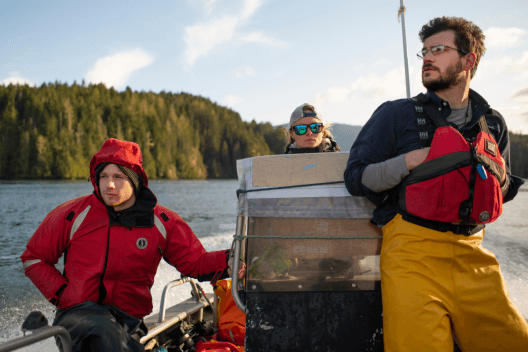Salmon virus originally from the Atlantic, spread to B.C. wild salmon from farms: Study
Salmon virus originally from the Atlantic, spread to B.C. wild salmon from farms: Study
Piscine orthoreovirus (PRV) – which is associated with kidney and liver damage in Chinook salmon – is continually being transmitted between open-net salmon farms and wild juvenile Chinook salmon in British Columbia waters, according to a new genomics analysis published today in Science Advances.
The collaborative study from the University of British Columbia (UBC) and the Strategic Salmon Health Initiative (SSHI) — a partnership between Fisheries and Oceans Canada (DFO), Genome BC and the Pacific Salmon Foundation — traces the origins of PRV to Atlantic salmon farms in Norway and finds that the virus is now almost ubiquitous in salmon farms in B.C.
It also shows that wild Chinook salmon are more likely to be infected with PRV the closer they are to salmon farms, which suggests farms transfer the virus to wild salmon.
Genome sequencing of viruses from farms and wild fish further indicates that transmission occurs between farms and wild salmon.
“Both our genomic and epidemiological methods independently came to the same conclusion, that salmon farms act as a source and amplifier of PRV transmission,” said Dr. Gideon Mordecai, a viral ecologist and Liber Ero fellow with UBC Science and researcher with UBC Medicine, who led the study. “Because separate lines of independent evidence all point to the same answer, we’re confident in our finding.”
Sequencing of 86 PRV genomes helped researchers track the history of PRV emergence in British Columbia. They estimate that the lineage of PRV in the North East Pacific diverged from PRV in the Atlantic Ocean approximately 30 years ago. This suggests that the introduction of PRV to B.C. and infection of wild Pacific salmon is a relatively recent phenomenon, coincident with the growth of salmon aquaculture in the province – not dating back to early attempts to introduce Atlantic salmon to the region, starting in 1874.
“There is much confusion about where PRV is originally from, whether it is transmitted between farmed and wild salmon, and how different lineages of the virus cause different severities of disease,” said Dr. Mordecai. “This study’s genome sequencing clearly indicates PRV is not native to B.C. waters—it originated in the Atlantic Ocean and has been spread around the world through salmon aquaculture.”
The study highlights the role of aquaculture in introducing novel pathogens to new regions, where they then spread to wild fish, and integrates the expertise of the two senior authors, Dr. Kristi Miller, a DFO scientist and Professor Jeffrey Joy, a UBC evolutionary geneticist. It demonstrates the value of genomics in the surveillance of viral pathogens affecting important fisheries resources and how analytical methods derived from the epidemiology of human viruses can be adapted and applied to conserving wild salmon populations.
Further analysis of PRV genomes generated by the study suggested that there has been a growth in the number of PRV infections in B.C. over recent decades. This finding corresponds with the regional growth in salmon aquaculture and high rates of viral infection in salmon farms.
“In contrast to the DFO’s assessment that PRV is not a disease agent, our study highlights evidence that PRV causes disease in BC.” says Dr. Mordecai. A recent Norwegian study found that a Canadian isolate of the virus causes heart lesions in Atlantic salmon. More importantly to the Pacific ecosystem, PRV has been associated with a different disease in Chinook salmon in which blood cells rupture, leading to kidney and liver damage.
“Our study reaffirms that a more precautionary approach to managing salmon farming in BC is warranted,” says study co-author Dr. Andrew Bateman, of the Pacific Salmon Foundation. “The PRV findings, in particular, support calls to transition from open-net salmon farming towards farming technology that doesn’t allow disease transfer between farmed and wild salmon, protecting BC’s wild Pacific salmon from serious risk in the process.”
“The study provides foundational information necessary to assess the risk of salmon aquaculture on wild fish, as recommended by the Auditor General of Canada’s 2018 Report on Salmon Farming, which criticized DFO’s ability to manage aquaculture in a precautionary manner,” says Professor Jeffrey Hutchings of Dalhousie University, a leading Canadian fisheries scientist who was not involved with the research. “The work by Mordecai, Miller, and colleagues on PRV provides the most compelling, scientifically objective evidence to date that wild salmon in BC are at increased risk of disease because of open net-pen Atlantic salmon aquaculture,” adds Professor Hutchings.
Interview language(s): English
Aquaculture mediates global transmission of a viral pathogen to wild salmon. (DOI 10.1126/sciadv.abe2592)
Media Inquiries, please contact:
Elayne Sun
esun@psf.ca



